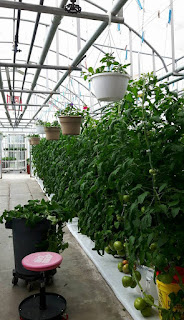After my workshops, I stayed on in Lethbridge for two more days to see some of the sights. I could not have asked for better weather for a trip to Waterton Lakes National Park. The lakes are a beautiful blue colour, and the water appears very pristine. The Park is in the southwest corner of Alberta, near the US border.

Kathy, who is the person that gets credit for bringing me to Alberta, accompanied me and served as my informal tour guide.
Waterton Lakes National Park and Glacier National Park (on the US side), form Waterton-Glacier International Peace Park. There is a plaque commemorating the formation of the International Peace Park in 1936 and the peaceful relationship between Canada and the US.
Kathy and I stopped off at the beautiful Cameron Falls,
which is where I shot this photo of a chipmunk.
The next morning Judy (whose photo appears in my previous blog post) arranged for me to accompany her to a Hutterite Colony. The Hutterites are an Anabaptist sect (much like the Amish and Mennonites). Anabaptists are opposed to infant baptism. All of these groups found a safe haven in Canada where they were not persecuted for their beliefs and refusal to go to war for their country (pacifism). The way that Hutterites differ from Amish and Mennonites is that they live in colonies. The one we visited holds about 110 people. I was allowed to take photographs of anything I wanted except the people that live there. It is forbidden by their religion. A quick google for Hutterites will get you to images quickly, and you will see that they dress in plain home-made clothing, with women wearing a kerchief on their heads. Two young women, perhaps in their late teens, took us around and explained everything.
The particular colony we visited is named "Spring Valley Colony". Essentially they are farmers and trades/crafts people.
Every skill they have acquired is practiced in volume. So you can see the size of the greenhouse. They have to feed 110 people from these tomato plants. In addition, they sell their products.
The women sew colourful rugs.
Like most farms, there are dogs and cats. The dogs are probably working dogs, used to herd sheep and cattle.
The milk house is very high tech. Machinery measures the milk output for each cow over time.
The pink paint on the cow heads below indicates that they have been seen by a vet. At this time of year there were numerous young calves as well.
Spring also brings many lambs.
There is a leatherwork shop where boots, shoes and moccasins are made.
There is a sizable woodworking shop where furniture, clocks and other decorative boards are created.
The Hutterites keep bees and make honey, both to eat and to sell.
The kitchen is fitted with top quality industrial style cooking equipment.
The men and women eat in separate dining rooms.
I was able to purchase some of these delicious dinner rolls before I left.
On Saturday I flew home. The first flight from Lethbridge to Calgary involves a quite small plane with only about 18 seats. I think it is probably the smallest plane I have traveled on. We flew so low that for much of the time we were able to pick up a Wifi signal.
A huge thank you to the Lethbridge Centennial Quilt Guild and the Textile Surface Design Group Lethbridge for inviting me to their city, for their warm welcome, and for taking such great care of me.






























Thanks for the tour. It was fascinating.
ReplyDelete